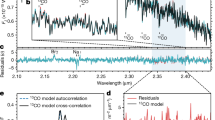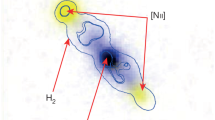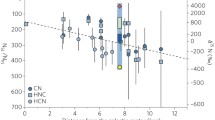Abstract
Abundances of hydrogen and helium isotopes in Jupiter and other giant planets can answer important questions on the origin of elements in the solar system and the nature of processes in the sun. The Galileo Probe entered Jupiter in late 1995. In January of 1998, raw data from the Galileo Probe Mass Spectrometer (GPMS) were placed on the internet at the website that is given below: http://webserver.gsfc.nasa.gov/code915/gpms/datasets/gpmsdata.html. From the raw data we estimate values of 3He/4He = (2.17±0.03) × 10-4 and 2H/1H = 1.0 × 10-4. These are higher than expected if the solar system formed from a homogeneous nebula (Wood, 1999) with subsequent production of excess 3He by deuterium burning in the sun (Geiss, 1993). It appears that Jupiter formed instead from elements with some of the same chemical and isotopic irregularities observed in meteorites.
Access this chapter
Tax calculation will be finalised at checkout
Purchases are for personal use only
Preview
Unable to display preview. Download preview PDF.
Similar content being viewed by others
References
Bernatowicz, T.J. and Podosek, F.A.: 1978, “Nuclear components in the atmosphere”, in Terrestrial Rare Gases, eds., Alexander, Jr., E.C. and Ozima, M., Center for Academic Publications Press, Tokyo, pp. 99–135.
Burbidge, E.M., Burbidge, G.R., Fowler, W.A. and Hoyle, F.: 1957, “Synthesis of the elements in stars”, Rev. Mod. Phys. 29, 547–650.
Cameron, A.G.W.: 1957, “Nuclear reactions in stars and nucleosynthesis”, Publ. Astron. Soc. Pac. 69, 201–222.
Chapman, S. and Cowling, T.G.: 1952, The Mathematical Theory of Non-Uniform Gases, Cambridge University Press, Cambridge, 431 pp.
Conrath, B.J., Gautier, D., Hanel, R.A. and Hornstein, J.S.: 1984, “The helium abundance of Saturn from Voyager measurements”, Ap. J. 282, 807–815.
Geiss, J.: 1993, “Primordial abundance of hydrogen and helium isotopes”, in Origin and Evolution of the Elements, eds., Prantzos, N., Vangioni-Flam, E. and Cassè, M., Cambridge University Press, Cambridge, pp. 89–106.
Geiss, J. and Bochsler, P.: 1991, “Long-term variations in solar wind properties. Possible causes versus observations”, in The Sun in Time, eds. Sonnett, C.P., Giampapa, M.S., and Matthews, M.S., Univ. Arizona Press, pp. 98–117.
Geiss, J. and Reeves, H.: 1981, “Deuterium in the solar system”, Astron. Astrophys. J. 93, 189–199.
Kaiser, W.A.: 1972, “Rare gas studies in Luna-16-G-7 fines by stepwise heating technique. A low fission solar wind xenon”, Earth Planet. Sci. Lett. 13, 387–399.
Mahaffy, P.R., Donahue, T.M., Atreya, S.K., Owen, T.C. and Niemann, H.B.: 1998, “Galileo probe measurements of D/H and 3He/4He in Jupiter’s atmosphere”, Space Science Reviews, 84, 251–263.
Manuel, O.K. and Hwaung, G.: 1983, “Solar abundances of the elements”, Meteoritics 18, 209–222.
Manuel, O.K. and Sabu, D.D.: 1975, “Elemental and isotopic inhomogeneities in noble gases: The case for local synthesis of the chemical elements”, Trans. Missouri Acad. Sci. 9, 104–122.
Manuel, O.K. and Sabu, D.D.: 1977, “Strange xenon, extinct superheavy elements and the solar neutrino puzzle”, Science 195, 208–209.
Manuel, O., Windler, K., Nolte, A., Johannes, L., Zirbel, J. and Ragland, D.: 1998, “Strange xenon in Jupiter”, J. Radioanal. Nucl. Chem. 238, 119–121.
Niemann, H.B., Atreya, S.K., Carignan, G.R., Donahue, T.M., Haberman, J.A., Harpold, D.N., Hartle, R.E., Hunten, D.M., Kasprzak, W.T., Mahaffy, P.R., Owen, T.C., Spencer, N.W. and Way, S.H.: 1996, “The Galileo probe mass spectrometer: Composition of Jupiter’s atmosphere”, Science 272, 846–848.
Robert, F., Javoy, M., Halbout, J., Dimon, B. and Merlivat, L.: 1987a, “Hydrogen isotope abundances in the solar system. Part I. Unequilibrated chondrites”, Geochim. Cosmochim. Acta 51, 1787–1805.
Robert, F., Javoy, M., Halbout, J., Dimon, B. and Merlivat, L.: 1987b, “Hydrogen isotope abundances in the solar system. Part II. Meteorites with terrestrial-like D/H ratio”, Geochim. Cosmochim. Acta, 51, 1807–1822.
Songaila, A., Wampler, E.J. and Cowie, L.L.: 1997, “A high deuterium abundance in the early universe”, Nature 385, 137–139.
Webb, J.K., Carswell, R.F., Lanzetta, K.M., Ferlet, R., Lemoine, M., Vidal-Madjar, A. and Bowen, D.V.: 1997, “A high deuterium abundance at redshift z = 0.7”, Nature 388, 250–252.
Wiens, R.C., Huss, G.R. and Burnett, D.S.: 1999, “The solar system oxygen-isotopic composition: Predication and implications for solar nebula processes”, Meteoritics. Planet. Sci. 34, 99–107.
Wood, J.A.: 1999, “Forging the planets: The origin of our solar system”, Sky and Telescope, 97, 36–48.
Author information
Authors and Affiliations
Editor information
Editors and Affiliations
Rights and permissions
Copyright information
© 2002 Kluwer Academic Publishers
About this chapter
Cite this chapter
Nolte, A., Lietz, C. (2002). Abundances of Hydrogen and Helium Isotopes in Jupiter. In: Manuel, O. (eds) Origin of Elements in the Solar System. Springer, Boston, MA. https://doi.org/10.1007/0-306-46927-8_39
Download citation
DOI: https://doi.org/10.1007/0-306-46927-8_39
Publisher Name: Springer, Boston, MA
Print ISBN: 978-0-306-46562-8
Online ISBN: 978-0-306-46927-5
eBook Packages: Springer Book Archive




